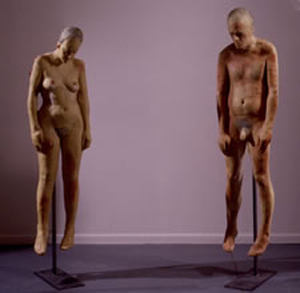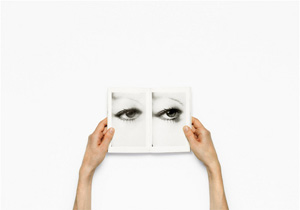Mind Your Manners
John Haberin New York City
The Wagner Collection: After Neo-Mannerism
Every artist has a fear, to become a cliché. And every critic has a dream, to coin one.
Who would not want to have named a movement, even if the art has grown stale? And who would not want to have named a trend, even you meant the term as an insult? With "Neo-Mannerism," Jerry Saltz has done both. Art today, Saltz argues, actually embraces its staleness. And then, wonder of wonders, Peter Schjeldahl in the same week's New Yorker modestly suggests that very term for a "condition that could do with a name." And so it could. 
Clearly something dangerous is in the air, and I shall offer my own coinage or two. But can art still live with danger? Saltz and Schjeldahl are right to have their doubts. Yet they can miss the big picture by sticking to the big galleries. They also miss the point of looking back. As a postscript, the gift of the Wagner collection to the Whitney shows how much more sense their criticism made a few years ago—and how much art has left that behind.
That knowing wink
Peter Schjeldahl writes modestly and precisely. His suggestion comes as a telling aside, after a review of the Carnegie International in Pittsburgh. He welcomes a wildly colored fence by Phyllida Barlow, within limits. She cozies up to steel slabs by Richard Serra, and she "easily mortifies his canonical dignity." Barlow's Post-Minimalism is "funny and gorgeous," and resistance is futile. Yet it still belongs to "ever more of what amounts to fungible brands."
Peter Schjeldahl and Jerry Saltz have a point, too. Who is not sick and tired of what Saltz calls "good imitations of bad art," Schjeldahl a "pastiche of installational foofaraw," and Walter Robinson "zombie formalism"? There seems way too much of practically everything these days—from conceptual art that wears its concept on its sleeve to macho, hyperactive, adolescent, and downright trashy installations. By "art's insidious new cliché," though, Saltz means something even safer. He means retreads of painting, with a smear and a knowing wink to show that both you and the artist see right through them, in yet another self-conscious display of beauty and smarts. He also gives credit where credit is due, to witty knockoffs of Jules Olitski by William Powhida.
Only recently, Mike Bouchet returns to text paintings and stereotypes of American culture, but in Diet Coke. (His own formula, Bouchet insists.) Sure, when it comes to precious bodily fluids, Andy Warhol was there first, with piss paintings. These days, though, the NSA might swoop in to conduct a drug test—or to clone his DNA along with his images. Ryan Estep, in turn, paints with a local anesthetic. If his abstractions look expressive, like Albert Oehlen but without computer drawings, he has simply lost control along with sensation.
I have covered much the same ground earlier. Back when Young British Artists like Damien Hirst and Chris Ofili became notorious, I dismissed them as "Neo-Neo." I have also used "Post-Renaissance" to describe the 1600s. I meant it as a compliment, too, and an aid to understanding. I wanted people to see Mannerism's canny twists on the preceding generation as familiar even today. Its critique renewed the High Renaissance, just as Postmodernism, ironically, has kept Modernism alive.
Maybe a term can never really take hold unless it is yesterday's news. And Saltz lets the clichés multiply. He adopts a prefix, Neo, that instantly labels the art old hat. Then he invokes Mannerism, a term that wrote off the entire late Renaissance as mannered. He describes artists as "junior postmodernists," where Postmodernism implies an art that has overstayed its welcome. To rub it in, this particular cliché may be an editor's misunderstanding. "Neo-Mannerism" appears only in the headline, not the text, where Saltz speaks eloquently of "that ever-expanding assembly of anemically boring, totally safe artistic clichés squeezing the life out of the art world right now."
It is a point that he has made before. As a critic of the market's drive toward chaos and commercialization, he wrote of the "battle for Babylon." Still, just what is so pressing and so new? It is a little late to complain about "theory" from the 1970s, when it really meant something. Besides, what style has not grown mannered over time? Remember Modernism, when the worst insult was to label painting as derivative? And why single out any style, now that anything goes?
Another kind of Mannerism
It is hard, too, to tar the present with a term unfair to the past. When Mannerism flourished, the strange poses and piercing lights of Pontormo, Rosso Fiorentino, Parmigianino, Andrea del Sarto and his Sacrifice of Isaac, late Michelangelo, Pieter Coecke van Aelst, and El Greco unsettled convention—and packed a wallop. It was a time of heightened spirituality, heightened physicality, heightened realism, heightened unreality, and heightened reflection. And then Mannerism petered out, much like movements to come from the late Baroque and Salon painting to much of art today. While I am taking credit, I have also compared John Currin and Lisa Yuskavage to Lucas Cranach in the 1530s. In each case, skill, exaggeration, and a reduction of objects to surfaces carries an unpleasant chill, even in Renaissance sculpture in bronze. For a while, though, there was deep thought and feeling, and there can still be today.
When artists look to recover something genuine in experience, they may recall Mannerism in another way as well: they may take the body as a locus of suffering. When Kiki Smith turns from the black steel of her father, Tony Smith, to the blackness of sensation, she, too, is revising and not just revisiting the past. So is "Counter Forms," where Tetsumi Kudo, Alina Szapocznikow, Paul Thek, and Hannah Wilke could well pass for a single artist. Their anxiety may feel self-imposed, as with Huma Bhabha, Thomas Houseago, or Magdalena Abakanowicz. Yet it is nothing if not sincere, and surely such artists as Cynthia Daignault respect both beauty and smarts.
Schjeldahl himself offers a corrective. He notes that Mannerism "cycled generic styles," but "sometimes brilliantly." He fears less remembrance of the past than "art-historical amnesia." He acknowledges a further corrective in renewed attention to folk art and outsider art as well. And those "fungible brand" he hates are undeniable. Enough is enough.
 Still, one should be wary of focusing on the brand names. Schjeldahl writes while on a business trip to a brand-name event, and Saltz has narrowed his sights further. He sees a dominant style and dominant dealers, rather than an art adrift. Elsewhere he complains of how artists lose too much when they join the "big four." I hate art fairs as much as anyone, but their real cost falls once again on midlevel artists and for dealers struggling day in, day out for attention.
Still, one should be wary of focusing on the brand names. Schjeldahl writes while on a business trip to a brand-name event, and Saltz has narrowed his sights further. He sees a dominant style and dominant dealers, rather than an art adrift. Elsewhere he complains of how artists lose too much when they join the "big four." I hate art fairs as much as anyone, but their real cost falls once again on midlevel artists and for dealers struggling day in, day out for attention.
Anyone can get caught up in auction prices and oversized galleries. They make headlines, and art critics can become insiders despite themselves. Still, a lot out there never receives a huge dollar sign or a headline. Big dealers even do everyone a favor, by attracting new audiences to art and making things happen within the gallery. It took big money in art to display late Picasso or Serra's early years, and if Mick Jagger or Matthew Day Jackson looks the worse for wear, money merely tempts them to indulge their usual bad instincts on a grander scale. The real problem lies in the increased financial pressure on everyone, including those who wish to respect tradition—or to break with it.
I do not mean to quibble over art history. The market is not going away, and neither are clichés. Yet anyone who thinks that the problem is too much sophistication should spend more time on studio visits. As the borders break down between Minimalism, realism, conceptual art, new media, and abstraction, art may either lose its impetus or discover new possibilities. Either way, artists now know too much to turn back. If there is hope for the present, it may lie after all in the self-consciousness of Mannerism.
The empty theater
The Whitney will never be the new kid on the block, but does it have to look so last year? It does when it displays a private collection. For thirty years, Thea Westreich Wagner and Ethan Wagner have devoted themselves to contemporary art, and therein lies a trap. The show captures a moment when art was clinging to conceptualism, but with decreasing irony, while painting was back in the game, but still in quotes. It brings to the museum both familiar faces and essential works, but a text painting by Christopher Wool comes perilously close to summing it up: the show is over.
The Wagners have given more than five hundred works to the Whitney and more than three hundred others, by European artists, to the Pompidou Center. Even a show as packed as this can display only a fraction. Wool appears first, with broad smears of black touched by color, and returns further on with narrower squiggles and with text art. He is not alone either in assuming multiple guises—like Richard Prince with his stale jokes and the Marlboro man, Robert Gober with industrial sinks and pretend newspaper bundles, Jeff Koons with a ceramic poodle and an ad for rum, Josephine Pryde with a cute kid and otherwise identical auto bodies disfigured by splashes of paint, or Liz Deschenes with green screens lit from within and an unsteady pattern of white dots. The recurring names serve a purpose. They appear not as focus points but as leitmotifs, in changing contexts. 
The curators mean only partly to praise the collectors' commitment to artists in a time of art fairs, art advisors, and flipping. Elisabeth Sussman and the Pompidou's Christine Macel also have a vision of contemporary art: artists are more than brands, with talent to spare and the ability to change, even as some themes will not go away. For them, as Ricco Albenda has it in another text painting, I was just thinking, but also inspiring. The cold eye of corporate America will suit Anne Collier, Christopher Williams, and Reena Spauling, too. Corrupted patterns and broken swirls will translate into inner tubes for Gareth James, a floral curtain for Simon Starling, a lattice of paint strips for Cheyney Thompson, and canvas as wallpaper for Annette Kelm.
That pays off until one tries to pin down the themes. The show breaks new ground for the Whitney, which has on view the Europeans along with Americans. As Ken Oklishi puts it in another title, Goodbye to Manhattan. Europe just happens to look a trifle more nostalgic and stately, like an old library in paint for Lucy McKenzie or gilt clocks for Pablo Bronstein. Still, both versions of the present feel overblown and confining. Like a marquee of fluorescent lights for Philippe Parreno, this theater is always open and always empty.
It comes down to that awkward moment in time. No doubt every collection enshrines one, like the Lauder collection of Cubism, and only the bravest collectors, like Gertrude and Leo Stein, go beyond the biases of the present. Here, though, the present looks already past. Big money corrupts, as when a museum touts a private collection in hope of a gift, but the Whitney has every reason to reward itself and collectors for a major acquisition. Still, it cannot chase away the scare quotes. If there is a Neo-Mannerism after all, for all the sense these days that art is too confused to look back, this is it.
Naturally the collection has its roots in the "Pictures generation," but with politics, race, and diversity mostly on hold. Gender takes on an edge for Larry Clark and Sherrie Levine, but Mike Kelley has his own rephotography of feminist art—which is like celebrating International Women's Day at a fraternity, kegs included. Lee Friedlander sticks for once to family photography, and even Cindy Sherman looks perfectly sincere. Abstraction is back, too, but with few hints of how interdisciplinary it has become. The gift is an advance for the Whitney, which in its reopening in the Meatpacking District all but came to an abrupt end thirty years ago. Still, it moves only hesitantly into the present.

Peter Schjeldahl wrote in The New Yorker of October 21, 2013, Jerry Saltz for New York magazine online shortly before. Mike Bouchet ran at Marlborough through November 9, Ryan Estep at Thierry Goldberg through November 10, and "Counter Forms" at Andrea Rosen through November 16. The Thea Westreich Wagner and Ethan Wagner collection ran at The Whitney of American Art through March 6, 2016.




